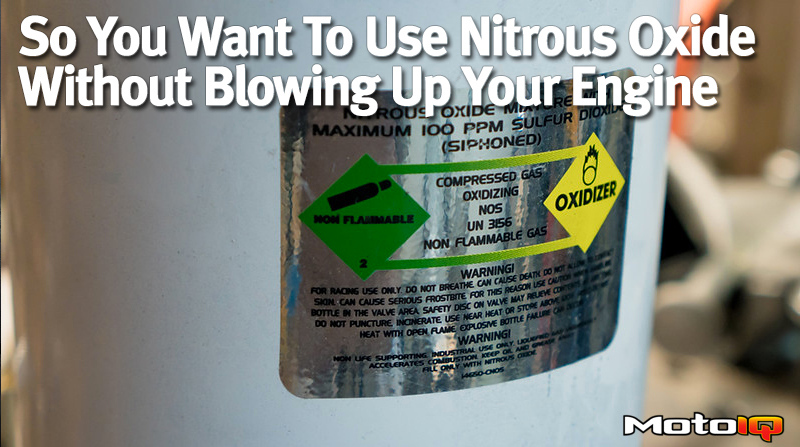, Horsepower is a function of cylinder pressure, RPMs, and displacement. Adding nitrous oxide increases cylinder pressure. Let's say you have 100 horsepower at 3000 RPMs. All other things remaining equal (especially cylinder pressure), you’ll have 200 horsepower at 6000 RPMs; twice the power at twice the RPMs. If you add a 50 shot of nitrous oxide at 6000 RPMs, that 25% power comes from your cylinder pressure increasing by 25%. If you add the same shot at 3000 RPMs, you’ll go from 100 horsepower to 150 horsepower, which is a 50% increase in cylinder pressure; twice as much stress on the engine. So if you decide you can add 50 horsepower at 6000 RPMs, then you can only add 25 horsepower at 3000 RPM, and if you accidentally hit the 50hp button at 3000 RPM, you are putting twice as much stress on your engine as you had planned.
The point of that wall of numbers in that last paragraph is that you should only use your nitrous oxide pretty close to the peak of your power curve, only when the throttle is all the way open, and only when you are sure you have fuel pressure. The best way to make sure you do this is to use a nitrous controller that looks at RPM, fuel pressure, and throttle position, and automatically activates and deactivates the nitrous oxide so you don’t have to pretend like you can keep track of all that stuff and still drive.
I know, nitrous controllers aren’t as cool as buttons. You want to hit that red button on the steering wheel at exactly the right time while the guy in the car next to you presses his too early, causing some sort of ambiguous manifold failure.
Eventually, however, you will be at a stoplight and accidentally press the nitrous button while reaching up to flick the hula doll on your dash. Fifty horsepower of nitrous oxide will immediately enter your engine which is spinning at a lazy 800 RPMs, launching you into the intersection where your engine will explode at the exact moment you get t-boned by a tour bus.
Everyone dies. This is why you need a nitrous controller.
Appropriate power
Auto manufacturers design engines for a lot of use cases like hauling stuff up a hill in the desert, 200,000 miles of use, and uncontrollable variations in mass production quality. Under normal conditions, you have some margin between your situation and the maximum stress the engine can handle. This is the margin that you are using up when you add nitrous to your stock engine. Sadly, this margin is not infinity.
 Some of these jets are very expensive, if you get my drift.
Some of these jets are very expensive, if you get my drift.It’s impossible to know what this margin is for you, as the use cases and manufacturing variability are unknown. But for those of you who want things to be massively oversimplified: you can probably safely and consistently add about 20% of whatever your car makes. If your engine came from the factory with 150 hp, you’re probably safe to put 30 hp of nitrous oxide on there and not do too much damage to the long-term reliability. Bigger engines can usually handle a little higher percentage; more displacement usually means more margin. A five-liter can probably handle 30%. A first-generation Dodge Viper can take a 50% increase in power without even breaking a sweat. These are all wild guesses based on some experience but zero actual engineering, and your results may reflect that.
In any case, give yourself a little bit more margin by retarding your timing, using colder spark plugs, and running higher octane gas. If you’re really looking for more power than your engine can stand, your first stop is probably better pistons with a bigger ring gap, and you might as well put new connecting rods in while you’re at it. It’s at this point that nitrous oxide starts to be not so cheap anymore.
On that note, it’s also important to consider how expensive the engine will be to replace, or rather how much disposable income you have. Make sure you can afford pay rent and replace your engine when you throw a rod through your neighbor’s shed because you took vague and questionable advice from a stranger on the internet. Remember that you can follow all the advice here and still have an engine failure because no matter how careful you are, you’re still adding a bunch of cylinder pressure to an engine that has hundreds of hot, moving, mass-produced parts. It will void all the warranties.
Nitrous oxide is one of the easiest and cheapest ways to increase your horsepower, but it is also really easy and cheap to make too much horsepower. There’s always that bad-idea voice in the back of your head saying “Dude, why are we adding 50 horsepower when we can add 700 for the same price!”
Resist the temptation.
Also, keep in mind that the bigger your shot, the more often you have to go have your tank refilled. Some people would call that a drawback, but here in Silicon Valley we like to think of a drawback as a “feature”. If you’re using so much nitrous oxide that you have to get your tank filled all the time, you’re having way too much fun. Too much fun = jail. Nitrous keeps you out of jail.
See? Feature.




6 comments
Does anyone sell a complete system, the pressure gages,controller., and the device to prevent nitros dump at too low rpm ? I mean all the parts in one kit.
You can set up control parameters not to do that.
Can you put a small amount of oxygen in before your carbie and add more fuel to it at the same time.
Not recommended.
I am thinking about buying a car with an already installed NOS system. Any tips?
I am considering buying a car that has a NOS system. It is a 2003 acura cl. Is this a good car to buy or am I better off with something like a Del Sol civic? I am also considering a 2005 mazda rx-8 but I dont know the reliability of the vehicle and wanted to get the opinion of fellow gearheads.